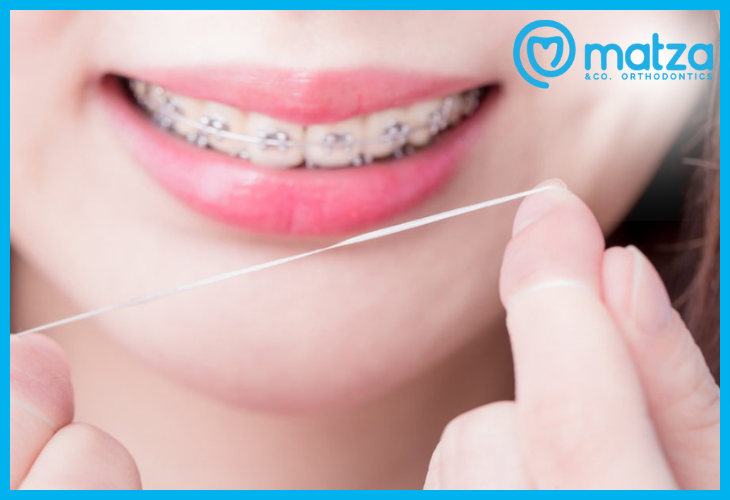How to Floss with Braces
Cleaning and flossing your teeth when you have braces is vitally important to your smile — and even your general health. It’s important to floss regularly to prevent gum disease and tooth decay while braces are working to align your teeth for a more confident smile. Here are some tips on how you can get it done!
Flossing, or using wax-covered thread to clean between teeth, scrubs the hard-to-reach places that are easily missed by brushes, especially with brackets and wires in the way. Floss between each tooth once a day, and use a small interproximal brush to clean around the brackets and under the wires.
Don’t skip flossing, even if it takes more time with your braces. These flossing techniques may make the process faster and easier. No matter which method you choose, it’s important to floss regularly to prevent gum disease and tooth decay while braces are working to align your teeth for a more confident smile.
Traditional flossing
This tried-and-true flossing technique is a great way to clean food and plaque from between teeth, but for people with braces, it can be a bit tricky. Threading the floss around the brackets and wire takes time.
Plan to give yourself 10 to 15 minutes to floss your teeth if you use this method. The only tool you will need is waxed floss. Unwaxed floss can tear and become stuck in the metal brackets.
How to use traditional floss with braces
- Cut an 18- to 24-inch piece of floss.
- Thread the floss between the main wire and your teeth. It helps to be in front of a mirror so you can watch the thread to make sure it’s going where you’d like it to.
- Wrap the ends of the floss around your index fingers to make handling the floss easier.
- Gently press the floss between the two teeth, and slide the floss up and down along the sides of both teeth. If you’re doing the top teeth, make an upside-down U shape: Go up the side of one tooth to the gumline, and then go down the side of the other tooth.
- Remove the floss, and gently unthread it from behind the wire. Be careful to not pop the floss out of the tooth. You might accidentally knock the wire and pop it out of the bracket.
- Move to the next pair of teeth, and repeat the process.
Waterpik or oral irrigator

A Waterpik is a unique tool that uses a steady stream of water to clean between teeth and along the gumline. A water flosser costs about $50, but some models are more expensive. Because of how efficient the stream of water is at cleaning your mouth, you only need three to five minutes to floss with this device.
Some brands of Waterpiks offer special tips for orthodontia. These tapered tips are able to clean around brackets and between teeth more easily than standard tips.
How to floss with a Waterpik
- Fill the machine’s water reservoir with water. You can add mouthwash to the water for an antibacterial bonus. However, this isn’t necessary.
- Insert the tapered tip on the water flosser. Press to send water through the flosser to make sure it’s working correctly and that the water pressure is strong enough for you.
- Lean over the sink, and place the tip of the flosser in your mouth.
- Turn the water flosser on. Close your lips to keep water from splashing out of your mouth. Allow the water to drain out of your mouth while you’re flossing.
- Glide the water stream along the gumline and between each tooth.
If you want, you can gently brush the tooth and brackets to loosen up any food or debris.
Then, spray between the teeth and along the gumline again.
Repeat this process along the front and back of each tooth.
When you’re finished, empty the reservoir of water, and dry the flosser tip. Store in a closed container to protect the tip.
Floss threader
You can speed up the traditional flossing method with an inexpensive but indispensable tool. This small, plastic tool is called a floss threader. A floss threader helps you pull floss behind the braces wire easily.
Using a floss threader will shave several minutes off your dental care routine. You can buy floss threaders at supermarkets or pharmacies in the oral care section. Your orthodontist may also have sample threaders they can give you to try before buying a full bag.
How to use a floss threader to floss with braces
- Pull an 18- to 24-inch piece of waxed floss through the eye of the floss threader.
- Insert the point of the plastic needle under the wire of your braces. Gently pull the floss through the wire. Hold the floss threader in one hand.
- Wrap the floss around your index fingers to give you more control over the thin thread.
- Gently press the floss between the two teeth, and slide it up and down along the sides of both teeth. If you’re doing the top teeth, make an upside-down U shape: Go up the side of one tooth to the gumline, and then go down the side of the other tooth.
- Gently pull the floss out from between the teeth, and pull the floss out from behind the wire.
- Rethread the floss threader, and repeat the process on the next set of teeth.
Dental tape
For some people, traditional flossing can be painful. This is especially true for people who have not routinely flossed before getting braces. Unhealthy gums can bleed and feel swollen when you first start flossing them. Over time, the gums will be healthier, and flossing may no longer hurt.
While your gums are sensitive, consider flossing with dental tape. This ultrathin floss is smooth and spongy. It’s thinner than typical floss and also wider like a ribbon. That helps it glide between teeth more easily.
Use dental tape the same way you would traditional floss.
General tips and tricks for flossing with braces
In addition to regular flossing, these best practices are a good way to help you keep your pearly whites shining bright.
Schedule regular cleanings
Cleanings from a dental hygienist are a good idea while you have braces. They can deep clean around the brackets and hardware and help prevent staining. Consider scheduling a cleaning every three months.
Don’t use whitening toothpastes
While you might think keeping your teeth bright white is a good idea, brushing with whitening toothpastes could create problems later on. Whitening products can’t get under the brackets, so only exposed areas of your teeth will be whitened. Once the brackets are off, you may have off-white areas on each tooth.
Consider using an electric toothbrush
Electric toothbrushes clean better than typical manual brushes, so you can get better results for less effort. Electric toothbrushes can cost $100 or more, but check with your dentist for a coupon or voucher.
Now is the perfect time to explore orthodontic options — don’t wait! Get yourself closer to the smile you’ve always wanted – or the one your child needs for their best health. We’re here to answer all the questions you might have! Dr. Matza is very well known in South Florida for his expertise. Call us at (561) 368-3480 or find us on Facebook.
Reference: [https://www.healthline.com/health/how-to-floss-with-braces#takeaway]
